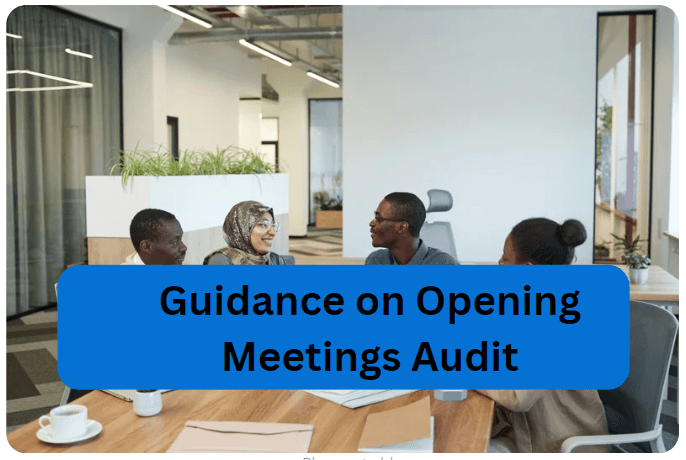In audit opening meeting our primary purpose shall be to confirm the audit plan and its arrangements. The opening meeting sometimes called a pre-audit conference or start-up meeting, is basically held at the location of the auditee. Good practice requires that the team of auditors arrive together at a set time. This meeting requires preparation by the team leader and the venue is usually a manager’s office or the organization’s conference room.

Opening Meetings Audit Explained:
First, start with the welcome and statement of introduction from a member of the auditee management. The auditor team should have come prepared with an agenda that will ensure that all necessary points are covered quickly and efficiently. It should be remembered that meeting may be the first time, two parties auditors and auditee have met therefore it is an opportunity to make introductions and explain audit approach.
Auditee will be kept informed of audit progress, guide, and observer availability and roles and responsibilities. Information about the closing meeting, complaints appeals clarification in a third-party audit is likely to be a degree of tension although the meeting is formal the team leader must try and relieve some of this tension.
Ground rules of the audit will be stated. In any case, it is an acceptable practice to define in advance who will be the signatories in case any nonconformity report is raised however care should be taken not to imply that this is the only purpose of an audit.
Do not forget to allow the auditee to ask questions during the opening meeting. In addition, the opening meeting provides insights into the management commitment and support.
The extent of the detail covered in an opening meeting should take into consideration how familiar the auditee is with the audit process. In the case of internal auditing, the opening meeting can be as basic as informing that an audit has been scheduled and describing its type. The opening meeting may be not all informal and may even include records for attendance.
Opening Meeting Checklist for Pharmaceuticals:
- Introduction of participants
- Roles of Lead auditor, auditor; auditee; guide; observer
- Attendance list (name; role, department, signature)
- Audit objective (reason for the audit)
- Audit scope (coverage of site; processes; clauses)
- Audit criteria (applicable requirements)
- Documentation status (changes since plan developed)
- Agenda plan (agenda; assignments; meetings; times)
- Audit methods (procedure; sampling; forms)
- Risk management (reduce risk from presence of audit team)
- Communications (auditee to be kept well-informed)
- Language (to be used during the audit)
- Confirmation of resources and facilities
- Confidentiality (results only to the auditee)
- Safety, security, and emergency considerations
- Reporting method (including severity grading, if any)
- Closing meeting (date, time, and location)
- Acknowledgments (who accepts nonconformities)
- Complaints or appeals (system for feedback)
- Concerns or questions (ready to begin audit?)
For more Refer to ISO 20011:2018 guidance on Opening meetings Audit.
Related Articles:
- Audit Check List Points for Warehouse
- Audit Check List for Engineering Department
- Audit Check List for Quality Assurance Pharmaceuticals
- Audit Checklist for Quality Control Department in Pharma
- Audit Checklist for Human Resource and Administration
- WHO-GMP Document Check List for Visitors
- Role of IPQA during Line Clearance

Naresh Bhakar is the Founder and Author at Pharmaguddu.com, bringing his extensive expertise in the field of pharmaceuticals to readers worldwide. He has experience in Pharma manufacturing and has worked with top Pharmaceuticals. He has rich knowledge and provides valuable insights and data through his articles and content on Pharmaguddu.com. For further inquiries or collaborations, please don’t hesitate to reach out via email at [email protected].
